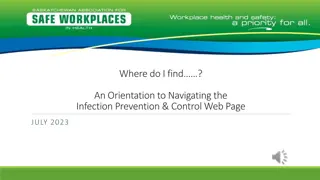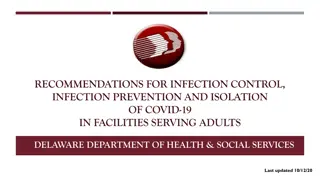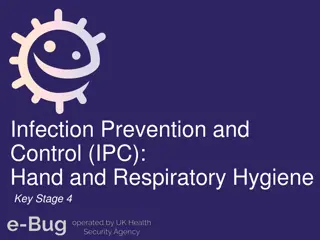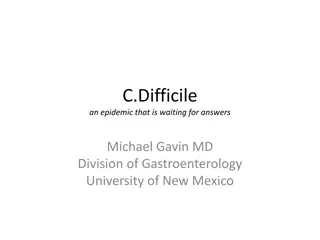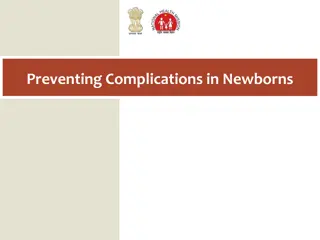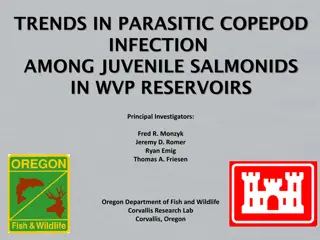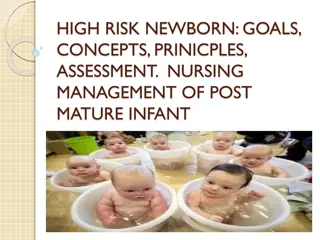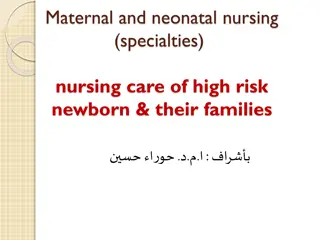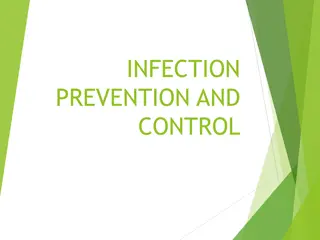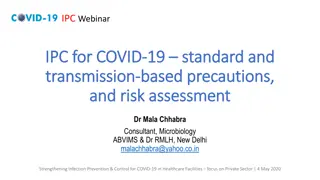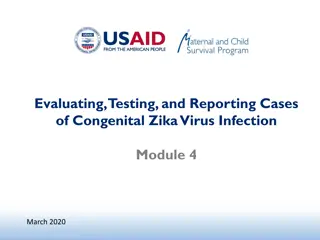Infection Prevention and Management in Newborns
This session focuses on the prevention, identification, and management of infections in newborns, discussing risk factors, infection prevention practices, and the use of antibiotics. Emphasizing the importance of hand hygiene, exclusive breastfeeding, and timely antibiotic use to reduce neonatal sepsis-related deaths. It also addresses risk factors related to mothers and newborn care while providing strategies to prevent infections in newborns.
Download Presentation

Please find below an Image/Link to download the presentation.
The content on the website is provided AS IS for your information and personal use only. It may not be sold, licensed, or shared on other websites without obtaining consent from the author. Download presentation by click this link. If you encounter any issues during the download, it is possible that the publisher has removed the file from their server.
E N D
Presentation Transcript
Prevention, Identification and Management of Infection in Newborn
Learning Objectives By the end of this session, learners will be able to: Discuss various risk factors for newborn infection Explain the identification and management of neonatal infection with or without symptoms Describe infection prevention practices and giving antibiotics to reduce deaths of newborns due to sepsis Describe the doses of antibiotics when FBNC is available or not Describe antiretroviral prophylaxis for newborns born to HIV+ve mother 2
Infection in Neonatal Period is a Leading Cause of Deaths in Newborn Deaths from neonatal sepsis can be reduced by Strict hand-washing practices while handling the baby Reducing un-necessary PV examinations Maintaining hygiene during delivery Early initiation of exclusive breast feeding Timely and judicious use of antibiotics Birth asphyxia 19% Infections 34% Others 5% Malforma tions 8% Preterm 34% Small babies (Pre term and SGA) are at a higher risk of acquiring infection and may require higher focus 3
Risk Factors for Newborn Infection Related to mother and delivery Related to Newborn care Very low birth weight, prematurity Failure to follow Infection prevention practices Lack of exclusive breastfeeding Poor monitoring of mother s temperature during 1st and 2nd stages of labor Poor hygiene and frequent handling Frequent vaginal examinations Unneeded newborn interventions such as routine suctioning of newborn PROM >18 hrs Prolonged labour>24 hrs/obstructed labour Pre-existing STIs/RTIs 4
Preventing Infection in Newborns Appropriately manage maternal infections and use antibiotic prophylaxis wherever needed Do not do un-necessary PV examinations during labour Maintain Six Cleans during delivery Perform hand hygiene every time before handling the baby Ensure early initiation of breast feeding and exclusive breast feeding, avoid pre-lacteal feeds Ensure dry cord care Avoid unnecessary interventions for the baby such as routine suctioning of newborns after birth 5
Principles for Antibiotics Use in Newborns Neonatal sepsis can be: When to use antibiotics: Clinical signs of neonatal sepsis Early onset within 72 hours (source of infection genital tract or delivery area) Mother had uterine infection during intrapartum period and upto 3 days (in these cases sepsis can develop) Late onset after 72 hours (source of infection hospital or community) Way to use: For the purposes of this presentation, we will focus only on early onset neonatal sepsis Therapeutic: Newborn with symptoms of infection Prophylactic: Asymptomatic newborns whose mother had infection 6
Asymptomatic Newborns with Maternal Conditions If following conditions were present at the time of delivery: o Mother had foul smelling discharge o Mother had fever (temp 380C) o Baby born <35 weeks of gestation with ROM >18 hours before birth FBNC available? Yes No Blood culture possible ? Shift to FBNC for antibiotics and further management Yes No Draw blood for culture, start antibiotics and refer to FBNC start antibiotics and refer to FBNC 7
Newborns with Symptoms of Infection Baby has very fast breathing (>60 per minute) or very slow breathing of newborn (<30 per minute) chest in drawing, grunting Convulsions Sick looking baby Baby has stopped breastfeeding Excessive crying or lethargic baby Fever (Temperature above 38 C) Hypothermic baby, not responding to warmth (Temperature below 36 C) Umbilical redness extending to skin or draining pus FBNC available? Yes No Blood culture possible ? Shift to FBNC for antibiotics and further management Yes No Draw blood for culture, start antibiotics and refer to FBNC start antibiotics and refer to FBNC 8
Dose and Type of Antibiotic Before Referral if FBNC is Not Available Weight Dose of Inj Gentamicin Dose of Amoxicillin Less than 1.5 kg To be referred to higher facility Above 1.5 kg upto 2.0 kg 0.2 ml 2 ml Above 2.0 kg upto 3.0 kg 0.3 ml 2.5 ml Above 3.0 kg upto 4.0 kg 0.4 ml 3 ml Route of administration Intramuscular Oral Dosage 5 mg/kg/dose Once a day 25mg/kg/dose Twice a day 9
Full Dose of Antibiotics to Newborn (FBNC) Frequency Antibiotic Each dose Route Duration <7 days age >7 days age Inj. Ampicillin or 50 mg/kg/dose 12 hourly 8 hourly IV, IM 7-10 days Inj. Cloxacillin 50 mg/kg/dose 12 hourly 8 hourly IV 7-10 days AND Inj. Gentamicin or 2.5 mg/kg/dose 12 hourly 8 hourly IV, IM 7-10 days Inj. Amikacin 7.5 12 hourly 8 hourly IV, IM 7-10 days mg/kg/dose 10
Supportive Care for Newborn with Signs of Infection Provide warmth, ensure consistently normal temperature Start intravenous line Inject Vitamin K (according to the weight) intramuscularly if not given immediately after birth Provide bag and mask ventilation with oxygen if breathing is inadequate Provide gentle physical stimulation, if apnoeic Avoid enteral feed if hemodynamically compromised 11
Anti Retroviral Prophylaxis for Newborn All the babies born to HIV positive mothers should receive 6 weeks of once daily* Nevirapine syrup Such newborns should be referred to ART centers after delivery after appropriate care Birth Weight of infant Dose (mg ) Dose (in ml ) Duration Birth weight >2.5 Kg 15 mg once daily 1.5 ml once a day Upto 6 weeks irrespective of exclusively breast fed or exclusive Replacement fed Birth weight >2Kg to <2.5 Kg 10 mg once daily 1 ml once a day Infants with birth weight <2 Kg 2 mg/kg once daily 0.2 ml/kg once daily 12
Key Messages Neonatal sepsis is the leading cause of neonatal deaths which can be reduced by simple evidence based practices Risk factors for newborn infections may be related to mother and delivery or to newborn and his/her care All the babies born to HIV infected mothers must be given Nevirapine syrup daily upto 6 weeks. 13




